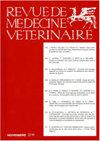Transferencia de embriones en yeguas receptoras anovulatorias
Q2 Veterinary
引用次数: 0
Abstract
This article discusses the main aspects of using hormonal protocols based on the application of estrogen followed by progestogen in anovulatory or acyclic recipients, either in anestrous or transition in embryo transfer protocols. Most mares demonstrate seasonally polyestrous behavior, by which they manifest estrus and ovulatory cycles during periods of higher daily luminosity. The annual reproductive cycle of mares is characterized by the presence of four phases defined by follicular dynamics: anestrous, spring transition, ovulatory, and autumn transition. During the phases of transition and anestrous, the incidence of ovulations decreases or is zero, making it difficult to synchronize ovulations between donors and recipients in preparation for embryo transfer. Some studies have shown that anovulatory/acyclic recipient mares managed with steroid-based protocols have similar uterine changes to those observed in pregnant mares. However, there is no sufficient research to allow to clarify the best steroid protocol with respect to dose, treatment times, and routes of administration.无排卵受体母马的胚胎移植
本文讨论了在无排卵或无循环受体中应用雌激素后孕激素的激素方案的主要方面,无论是在无排卵或胚胎移植方案中的过渡。大多数母马表现出季节性的多色行为,它们在每天亮度较高的时期表现出发情和排卵周期。母马的年度生殖周期以卵泡动力学定义的四个阶段为特征:发情、春季过渡、排卵期和秋季过渡。在过渡期和发情期,排卵发生率降低或为零,这使得为胚胎移植准备的供体和受体之间难以同步排卵。一些研究表明,使用类固醇治疗的无排卵/无循环受体母马与怀孕母马的子宫变化相似。然而,没有足够的研究来阐明关于剂量、治疗时间和给药途径的最佳类固醇方案。
本文章由计算机程序翻译,如有差异,请以英文原文为准。
求助全文
约1分钟内获得全文
求助全文
来源期刊

Revue De Medecine Veterinaire
农林科学-兽医学
CiteScore
1.30
自引率
0.00%
发文量
0
审稿时长
18-36 weeks
期刊介绍:
The Revue de Médecine Vétérinaire publishes four kinds of text:
1) Scientific reviews on subjects related to veterinary and comparative medicine. Suggested length: 10 to 30 typed pages.
2) Original reports on fundamental or applied research. Suggested length: 10 to 15 typed pages.
3) Continuous education articles, that should be easily understandable by non-specialists. Suggested length: 10 to 15 typed pages.
4) Clinical reports. Suggested length: 5 to 15 typed pages.
The publication can be done in French language or English language.
For an article written in English by not english native speakers authors, the manuscript must be subjected by attesting that it was read again by an anglophone scientist or a scientific translator.
The authors must certify that the manuscript was not published or subjected for publication to another review.
The manuscript must be accompanied by a sheet signed by all the joint authors indicating their agreement for the tender of the manuscript.
The publication is free but a financial participation could be required for the photographs color. An estimate will be sent to collect the agreement of the authors.
 求助内容:
求助内容: 应助结果提醒方式:
应助结果提醒方式:


